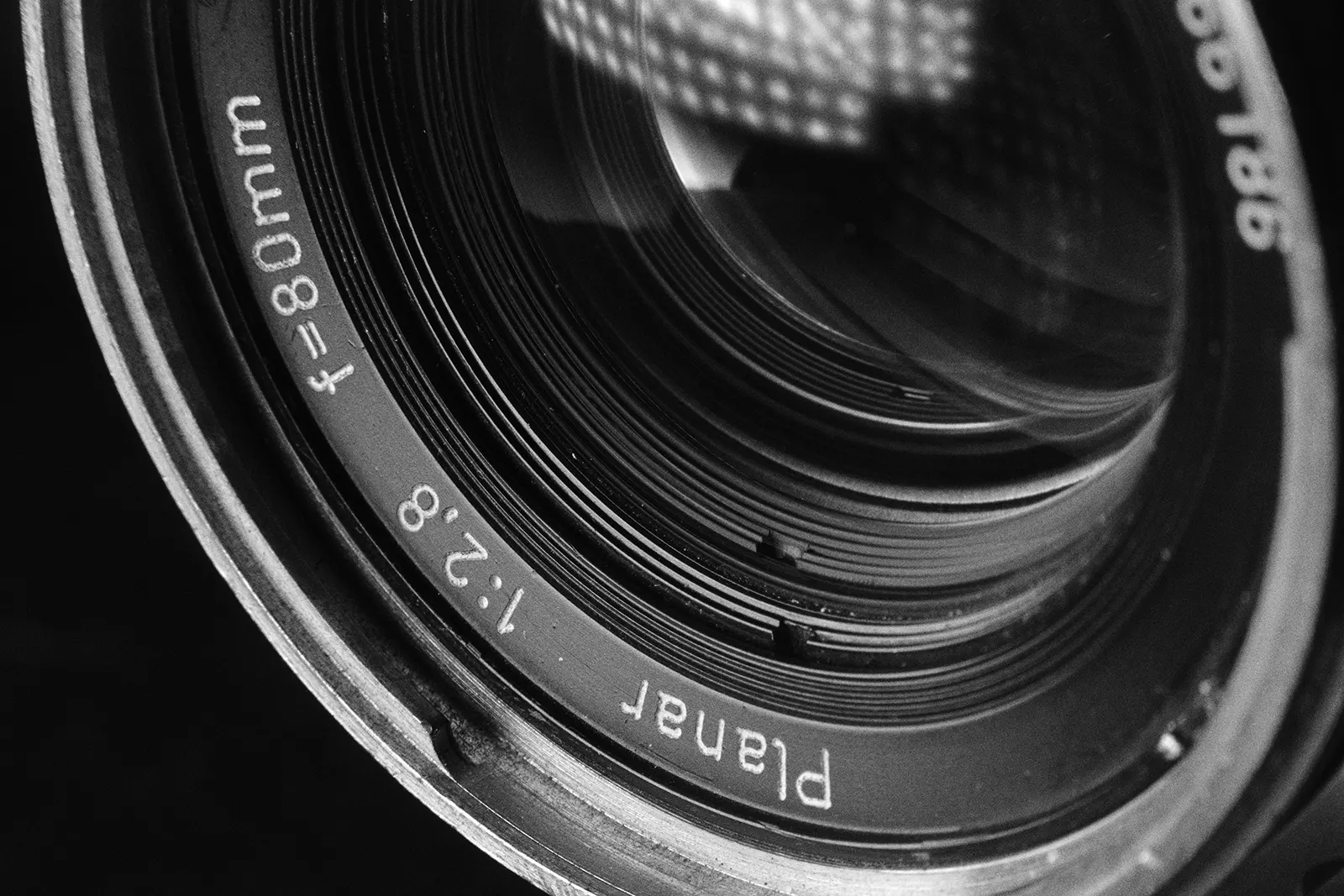The Zeiss Planar 80mm is a photographic lens designed by Paul Rudolph at Carl Zeiss in 1896. Rudolph’s original was a six-element symmetrical double Gauss lens design. While very sharp, early versions of the lens suffered from flare due to its many air-to-glass surfaces. Before the introduction of lens coating technology, the four-element Tessar, with slightly inferior image quality, was preferred due to its better contrast. In the 1950s, when effective anti-reflective lens coatings became available, coated Planars were produced with much-improved flare resistance. These lenses used the Zeiss T coating system, which had been invented by Olexander Smakula in 1935.
They performed very well as normal and medium-long focus lenses for small and medium format cameras. One of the most notable Planar lenses is the high-speed f/2.0/110 mm lens for the 2000- and 200-series medium format Hasselblad cameras with a similar version available for the Rolleiflex 6000 series cameras.
Photographic lens design
The design of photographic lenses for use in still or cine cameras is intended to produce a lens that yields the most acceptable rendition of the subject being photographed within a range of constraints that include cost, weight and materials.
For many other optical devices where the visual image is observed but often not recorded the design can often be significantly simpler than is the case in a camera where every image is captured on film or image sensor and can be subject to detailed scrutiny at a later stage. Photographic lenses also include those used in enlargers and projectors.

Lens elements
Except for the most simple and inexpensive lenses, each complete lens is made up from a number of separate lens elements arranged along a common axis. The use of many lens elements serves to minimise aberrations and to provide a sharp image free from visible distortions. To do this requires lens elements of different compositions and different shapes. To minimise chromatic aberrations, e.g., in which different wavelengths of light are refracted to different degrees, requires, at a minimum, a doublet of lens elements with a positive element having a high Abbe number matched with a negative element of lower Abbe number.
With this design one can achieve a good degree of convergence of different wavelengths in the visible spectrum. Most lens designs do not attempt to bring infrared wavelengths to the same common focus and it is therefore necessary to manually alter the focus when photographing in infrared light. Other kinds of aberrations such as coma or astigmatism can also be minimized by careful choice of curvature of the lens faces for all the component elements. Complex photographic lenses can consist of more than 15 lens elements.
Most lens elements are made with curved surfaces with a spherical profile. That is, the curved shape would fit on the surface of a sphere. This is partly to do with the history of lens making but also because grinding and manufacturing of spherical surface lenses is relatively simple and cheap. However, spherical surfaces also give rise to lens aberrations and can lead to complicated lens designs of great size. Higher-quality lenses with fewer elements and lower size can be achieved by using aspheric lenses in which the curved surfaces are not spherical, giving more degrees of freedom to correct aberrations.
がらす
The majority of photographic lenses have the lens elements made from glass although the use of high-quality plastics is becoming more common in high-quality lenses and has been common in inexpensive cameras for some time. The design of photographic lenses is very demanding as designers push the limits of existing materials to make more versatile, better-quality, and lighter lenses.
As a consequence many exotic glasses have been used in modern lens manufacturing. Caesium and lanthanum glass lenses are now in use because of their high refractive index and very low dispersion properties. It is also likely that a number of other transition element glasses are in use but manufacturers often prefer to keep their material specification secret to retain a commercial or performance edge over competitors.
ひ
Until recent years, focusing of a camera lens to achieve a sharp image on the film plane was achieved by means of a very shallow helical thread in the lens mount through which the lens could be rotated, moving it closer or further from the film plane. This arrangement, while simple to design and construct, has some limitations, not least the rotation of the greater part of the lens assembly including the front element. This could be problematic if devices such as polarising filters are used that require accurate rotational orientation irrespective of focus distance.
Later developments adopted designs in which internal elements were moved to achieve focus without affecting the outer barrel of the lens or the orientation of the front element.
Many modern cameras now use automatic focusing mechanisms which use ultrasonic motors to move internal elements in the lens to achieve optimum focus.
かいし
The aperture control, usually a multi-leaf diaphragm, is critical to the performance of a lens. The role of the aperture is to control the amount of light passing through the lens to the film or sensor plane.
An aperture placed outside of the lens, as in the case of some Victorian cameras, risks vignetting of the image in which the corners of the image are darker than the centre. A diaphragm too close to the image plane risks the diaphragm itself being recorded as a circular shape or at the very least causing diffraction patterns at small apertures. In most lens designs the aperture is positioned about midway between the front surface of the objective and the image plane. In some zoom lenses it is placed some distance away from the ideal location in order to accommodate the movement of floating lens elements needed to perform the zoom function.
Most modern lenses for 35mm format rarely provide a stop smaller than f/22 because of the diffraction effects caused by light passing through a very small aperture. As diffraction is based on aperture width in absolute terms rather than the f-stop ratio, lenses for very small formats common in compact cameras rarely go above f/11 (1/1.8″) or f/8 (1/2.5″), while lenses for medium- and large-format provide f/64 or f/128.

Very-large-aperture lenses designed to be useful in very low light conditions with apertures ranging from f/1.2 to f/0.9 are generally restricted to lenses of standard focal length because of the size and weight problems that would be encountered in telephoto lenses and the difficulty of building a very wide aperture wide angle lens with the refractive materials currently available. Very-large-aperture lenses are commonly made for other types of optical instruments such as microscopes but in such cases the diameter of the lens is very small and weight is not an issue.
Many very early cameras had diaphragms external to the lens often consisting of a rotating circular plate with a number of holes of increasing size drilled through the plate.[3] Rotating the plate would bring an appropriate sized hole in front of the lens. All modern lenses use a multi-leaf diaphragm so that at the central intersection of the leaves a more or less circular aperture is formed. Either a manual ring, or an electronic motor controls the angle of the diaphragm leaves and thus the size of the opening.
The placement of the diaphragm within the lens structure is constrained by the need to achieve even illumination over the whole film plane at all apertures and the requirement to not interfere with the movement of any movable lens element. Typically the diaphragm is situated at about the level of the optical centre of the lens.
80mm Tessar & Sonnar
The Tessar is a photographic lens design conceived by the German physicist Dr. Paul Rudolph in 1902 while he worked at the Zeiss optical company and patented by Zeiss in Germany; the lens type is usually known as the Zeiss Tessar. Since its introduction, millions of Tessar and Tessar-derived lenses have been manufactured by Zeiss and other manufacturers, and are still produced as excellent intermediate aperture lenses. The Tessar design uses four spherical lens elements in three groups, one positive crown glass element at the front, one negative flint glass element at the center and a negative concave flint glass element cemented with a positive convex crown glass element at the rear.
Its name derives from the Greek word τέσσαρες (Thessares), meaning ‘four’ in relation to its four lenses; endowed with excellent sharpness, it was nicknamed Adlerauge (Eagle’s Eye) in German. The Zeiss Sonnar is a photographic lens originally designed by Dr. Ludwig Bertele in 1929[1] and patented by Zeiss Ikon. It was notable for its relatively light weight, simple design and fast aperture. The name “Sonnar” is derived from the German word “Sonne”, meaning sun. It was originally a tradename owned by Nettel Camerawerke in Sontheim am Neckar for a f/4.5 Tessar-like lens. Sontheim’s coat of arms includes a symbol of the sun. Nettel merged with August Nagel’s Contessa Camerawerke in 1919. The resulting Contessa-Nettel AG in Stuttgart was one of the companies that merged to form the Zeiss Ikon AG in 1926.
When the modern Zeiss lens was designed by Bertele, Zeiss re-used the old Nettel tradename in order to build on the sun association to emphasize on the lens’ large aperture (f/2.0), which was much greater than many other lenses available at the time.
